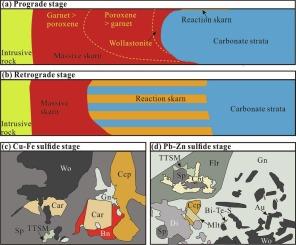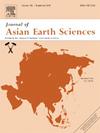Cobalt-Te-Au occurrence, genesis, and metallogenic potential of the Jiama skarn orebody, Tibet, China
IF 2.4
3区 地球科学
Q2 GEOSCIENCES, MULTIDISCIPLINARY
引用次数: 0
Abstract
Located in the Eastern Gangdese belt of Tibet, the Jiama skarn orebody is a Cu-polymetallic orebody with significant Pb, Zn, Au, and Ag by-products. The genesis of this orebody is revealed through an analysis of Co, Au, Ag, and Te occurrences. Based on textural and mineralogical relationships, ore formation can be divided into three paragenetic stages. Stage I, the prograde skarn phase, resulted in the formation of andradite, diopside, and wollastonite. This was succeeded by a retrograde period encompassing two sulfide stages—Stage II (Cu-Fe sulfides) and Stage III (Pb-Zn sulfides)—both of which are characterized by the deposition of various sulfides with quartz and calcite. Cobalt was identified in two forms: as the discrete minerals cobaltite (CoAsS) and carrollite ((Ni,Cu)Co2S4), and as an isomorphous substitution enriching sulfides. Tellurium is present within melonite, and Au occurs as native gold. Comparison between ore concentrate powder and ore shows loss of Co and enrichment of Au and Ag during beneficiation. Mantle-derived magma and/or juvenile lower crust involvement was likely during Jiama mineralization based on Co-Te-Au mineralization and other isotope characteristics. Three ore-forming fluids were revealed by the mineral assemblages of Co-Te-Au-Ag-Bi. The first ore-forming fluid was accompanied by Co-Cu mineralization and occurred at ΔNNO of 0.4 to 3.9; the second ore-forming fluid was accompanied by Co-Pb-Zn mineralization, while the last phase was dominated by Pb-Zn-Ag-Au-Bi-Te mineralization and occurred at logƒS2 of −12.8 to −8.3 and logƒTe2 of −10.5.

通过Co、Au、Ag、Te的赋存分析,揭示了该矿体的成因。根据构造和矿物学关系,成矿可分为三个共生阶段。第1阶段为渐进矽卡岩阶段,形成安长石、透辉石和硅灰石。随后是一个包含两个硫化物阶段的逆行期——第二阶段(Cu-Fe硫化物)和第三阶段(Pb-Zn硫化物)——这两个阶段的特征都是各种硫化物与石英和方解石的沉积。钴以两种形式存在:一种是钴酸盐(CoAsS)和钴酸盐((Ni,Cu)Co2S4),另一种是同晶取代富集硫化物。碲存在于麦龙岩中,金以天然金的形式存在。精矿粉矿与原矿的对比表明,在选矿过程中Co有损失,Au和Ag有富集。根据Co-Te-Au矿化及其他同位素特征,甲马成矿过程中可能存在幔源岩浆和(或)幼年下地壳参与作用。通过Co-Te-Au-Ag-Bi矿物组合揭示了3种成矿流体。第一次成矿流体伴生有Co-Cu成矿作用,发生在0.4 ~ 3.9°ΔNNO;第2期成矿流体以Co-Pb-Zn成矿为主,第1期成矿流体以Pb-Zn-Ag-Au-Bi-Te成矿为主,成矿时间为logƒS2(−12.8 ~−8.3)和logƒTe2(−10.5)。
本文章由计算机程序翻译,如有差异,请以英文原文为准。
求助全文
约1分钟内获得全文
求助全文
来源期刊

Journal of Asian Earth Sciences
地学-地球科学综合
CiteScore
5.90
自引率
10.00%
发文量
324
审稿时长
71 days
期刊介绍:
Journal of Asian Earth Sciences has an open access mirror journal Journal of Asian Earth Sciences: X, sharing the same aims and scope, editorial team, submission system and rigorous peer review.
The Journal of Asian Earth Sciences is an international interdisciplinary journal devoted to all aspects of research related to the solid Earth Sciences of Asia. The Journal publishes high quality, peer-reviewed scientific papers on the regional geology, tectonics, geochemistry and geophysics of Asia. It will be devoted primarily to research papers but short communications relating to new developments of broad interest, reviews and book reviews will also be included. Papers must have international appeal and should present work of more than local significance.
The scope includes deep processes of the Asian continent and its adjacent oceans; seismology and earthquakes; orogeny, magmatism, metamorphism and volcanism; growth, deformation and destruction of the Asian crust; crust-mantle interaction; evolution of life (early life, biostratigraphy, biogeography and mass-extinction); fluids, fluxes and reservoirs of mineral and energy resources; surface processes (weathering, erosion, transport and deposition of sediments) and resulting geomorphology; and the response of the Earth to global climate change as viewed within the Asian continent and surrounding oceans.
 求助内容:
求助内容: 应助结果提醒方式:
应助结果提醒方式:


